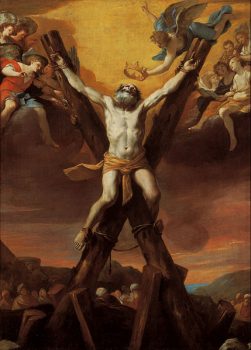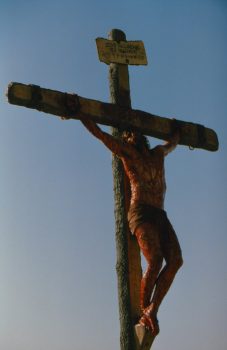Crucifixion was a regular mode of capital punishment among early pagan nations, and most likely originated with the Persians and then spread to the Assyrians, Germans, Celts, Britons and others. This punishment was “primarily reserved for traitors, captive armies, slaves and the worst of criminals” and was common under the rule of Alexander the Great (356-323 BC).1 Crucifixion was only used occasionally by ancient Jews, while their usual method of capital punishment, according to the Mosaic law, included stoning, burning, beheading, and strangling.2
Methods of crucifixion varied considerably depending upon location and time period and, when used, it was a most horrible form of torture and execution that involved fixing a person to a wooden post or tree using ropes or nails.3 Crucifixion is well-known today only because it was the method of execution used in the death of Jesus Christ.

Important Facts about the Crucifixion Cross
We must first understand a very important fact — the word “cross” is derived, not from its physical shape, but comes from the Latin “crux” (pronounced: kruhks), which referred to a tree or any construction of wood used to hang criminals as a form of execution. It was only later that crux came to refer specifically to a contemporary cross.4 There are four basic structures or types of cruxes that were used for crucifixion:
- Crux Simplex – this is a plain wooden stake, without a cross beam, used either by affixing the victim to it or by impaling him with it.
- Crux Commissa – this cross is T-shaped. Sometimes its three ends are expanded, therefore making it shaped like the Greek letter tau.
- Crux Decussata – a saltire (cross with equal-length diagonal bars), also called Saint Andrew’s Cross, is the shape of the letter X in Roman type.
- Crux Immissa – this cross, with a horizontal cross beam, is the best-known symbol of Christianity, because it is visualized as the cross used for the crucifixion of Jesus.

There is sometimes argument concerning the type of cross used in Jesus’ execution. Most Christians assume it was the Crux Immissa (pole with crossbeam), because that is the most used artistic representation seen today. But a few denominations, particularly Jehovah’s Witnesses, suggest (almost promote) the idea that it was the Crux Simplex (single pole). Without having been there to observe the crucifixion, we can only speculate, but research can give additional information from which we can make our own decision about what method was used.
When crucifixion was used for execution in the Old Testament, it usually consisted of a single wooden stake. The body was either impaled with the stake, such as dictated by the Persian King Darius (Ezra 6:11), or tied or nailed to it and then the corpse was left to rot. But when crucifixion was used by the Jews, or as punishment to a Jew by other peoples, the Mosaic law stated that the “corpse must not remain all night upon the tree; you shall bury him that same day” (see Deuteronomy 21:23, NRSV).5
On What Type of Cross was Jesus Crucified?
Even the Roman method of crucifixion, used during Jesus’ time, varied greatly. Roman philosopher Seneca the Younger (4 BC – AD 65) said of his travels that he saw crosses “not just of one kind but made in many different ways: some have their victims with head down to the ground; some impale their private parts; others stretch out their arms on the gibbet.”6

Although there are many references, in the Bible and in paintings, of Jesus carrying his own cross (at least part way), it was very unlikely that he or any single person did, because the whole cross could have weighed over 300 pounds (136 kg). In some cases however, those condemned to death were forced to carry only the crossbeam of a Crux Immissa, which weighed much less.7 Many modern scholars take the Gospel descriptions of Jesus (and then Simon), carrying only a crossbar to the pole already set in the ground at Golgotha.8
In the books of Matthew, Mark, and Luke, are described similar accounts of a passer-by being recruited to carry Jesus’ cross. In Luke 23:26 it states: “As they led him away, they seized a man, Simon of Cyrene, who was coming from the country, and they laid the cross on him, and made him carry it behind Jesus.”9 It is very possible, I guess, that the man ‘helped’ Jesus by lifting and carrying one end of the cross to help with its transport.
There is another possibility, too. Maybe Jesus could have carried the whole cross, if it was a single pole — a Crux Simplex. The Apostle John said, “So they took Jesus; and carrying the cross by himself, he went out to what is called ‘The Place of the Skull,’ which in Hebrew is called Golgotha” (John 19:16-17). The word translated “cross” in this instance is the Greek staurŏs, which can mean a stake, post, pole, or cross.10

Conclusion
As you can see, there is a lot more to the story, but nothing specific to indicate the exact type of crux that was used in the crucifixion of Jesus. We can only state with certainty that he died by crucifixion, but not by which variety of crux. Does it really matter? Well, I guess so to some extent, just so we could have an accurate account, but looking at the bigger picture, it is what he died for that is most important, not the shape or construction of the crux.
I guess that Jehovah’s Witnesses and a few others could be right in that Christ was crucified on a single pole — but then again, the same could be said for those folks in the majority, who say it was on a pole with a crossbeam. As a matter of fact, it could also have been neither of those types. The only real fact is that we just don’t know for sure.
Update: 13 March 2021
Since writing this article, there has been another study published, that considers some issues concerning the time of Jesus’ death and resurrection. It addresses the debate about if Jesus really died on Friday and was raised on Sunday. That article is titled “Was Jesus in the Tomb for Three Days and Three Nights?” and the link is: https://outlawbiblestudent.org/was-jesus-in-the-tomb-for-three-days-and-three-nights/
Update: 19 January 2023
Another article related to this subject is available. The title is “Crucifixion thoughts & How did they get the nails out?” The link is: https://outlawbiblestudent.org/crucifixion-thoughts-how-did-they-get-the-nails-out/
![]()
Copyright © 2018, Dr. Ray Hermann
OutlawBibleStudent.org
→ Leave comments at the end, after References & Notes.
OBS respects your privacy and is compliant with the European Union GDPR regulation. Click here to read.
References & Notes
1. Fairchild, Mary, “Facts About Jesus’ Crucifixion,” (ThoughtCo., 6 March 2017), https://www.thoughtco.com/facts-about-jesus-crucifixion-700752
2. Hirsch, Frank E., “Punishments,” (Bible Study Tools, retrieved June 20, 2018), https://www.biblestudytools.com/encyclopedias/isbe/punishments.html
3. Barry, John D., (Ed.), The Lexham Bible Dictionary, (Bellingham WA: Lexham Press, 2016).
Crucifixion: (σταυροω, stauroō, “put up posts”; cruci affigare, “bind to a cross”; תלה, tlh, “hang”; צלב, tslb, “hang”).
4. “Crucifixion,” (Wikipedia, Wikimedia Foundation, Inc., 5 June 2018), https://en.wikipedia.org/wiki/Crucifixion
5. Elwell, Walter A., (Ed.), Baker Encyclopedia of the Bible, (Grand Rapids, MI: Baker Book House, 1988), vol. 1, pp. 555-556.
6. “Crucifixion,” (Wikipedia, Wikimedia Foundation, Inc., 5 June 2018), https://en.wikipedia.org/wiki/Crucifixion
7. Ibid.
8. “Christ Carrying the Cross,” (Wikipedia, Wikimedia Foundation, Inc., 12 April 2018), https://en.wikipedia.org/wiki/Christ_Carrying_the_Cross
9. Unless otherwise noted, scripture quotations are from the New Revised Standard Version Bible (NRSV), ©1989 the Division of Christian Education of the National Council of the Churches of Christ in the United States of America. Used by permission. All rights reserved.
10. Strong, James, The New Strong’s Complete Dictionary of Bible Words, (Nashville, TN: Thomas Nelson Publishers, 1996).
Strong’s Greek #4716: σταυρός, staurŏs, stŏw-ros´; from the base of #2476; a stake or post (as set upright), i.e. (spec.) a pole or cross (as an instrument of capital punishment).


We can only state by certainly the he was crucified, actually, no you can not state by certainty. No actual proof that he even existed.
Thank you for visiting the OBS site and taking the time to share your opinion.
Do Note… the High Sabbath Versus the Weekly Sabbath (John 19:31).
Thank you for reading this article and for taking the time to write and leave a comment.
Valuable information. Fortunate me I discovered your website by chance. I’m a Jehovah witness! They insist it is only a pole. I bookmarked your page.
Thanks for stopping by the website. I hope you come back often.
In reply to ha-das.
Hi ha-das, Norm this end. I do hope you are doing well. I am only guessing here in my response to your comment about a pole was used for the crucifixion of CHRIST, guessing in as much that you may not have seen a short 5 Min. clip on youtube by Chuck Missler called (“The appearance of the cross in the Old Testament”) regarding the placement of the 12 tribes around the Tabernacle in the wilderness.
The headcount and tribe grouping placed them in their allotted position around the Tabernacle in the form of a cross. Interesting.
I have heard that Jehovah Witnesses have restrictions on searching outside of their elders teaching, true or false on that I do not. Anyway, do what you will with the suggested information and I wish you and your family GOD’s blessings and thank you for this platform to be able to comment.
So you are a witness and you say that THEY insist???? First of all Jehovah’s witnesses don’t “say” things, the BIBLE does. And yes it is very important to know what Jesus was tortured and died on because the “cross” is the emblem of catholicism who misled many millions of people with their lies. Jesus died on a stake, Greek “stauros”, not a pagan symbol.
Witnesses say a lot. And they certainly don’t promote a view that the bible is good enough on its own. Your comment was misleading. The JW cult strictly controls beliefs of its members and condemns any critical thinking that might lead to anything contrary to their interpretations. This arrogance exists despite being guilty of more than a few end of days predictions. Specific dates predicted as prophecy fullfillments are the work of prophets. There are no more prophets today. And than when they realize they were wrong they just say the light has gotten brighter…nothing suspicious here…. Quite convenient. Individual JWs can be great people but this group as a whole is an late 19th early 20th century Freemason spawned attempt at a theocratic one world order through the works of men. That’s not biblical.
Thanks , I’ve been searching for info on this subject for a long time and yours is the best I’ve discovered so far. It is really helpful to know that the cross is not a shape but the tool used, no matter what its shape was.
Thank you for leaving your comment. I am glad this information was helpful.